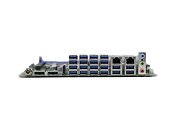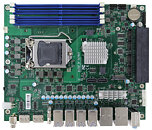Monday, September 21st 2020

Portwell Builds Intel Xeon Motherboard with 20 USB Ports
Have you ever felt the need that your motherboard needs more ports? Different peripherals can occupy quite a lot of USB ports and almost fill up all of them quickly. That is where the Portwell PEB-9783G2AR motherboard comes into play. Being built on Intel's latest W480E/Q470E chipset designed to accommodate any 10th generation 10 core CPU with a TDP of up to 80 W, the board can run either a Xeon W CPU or regular Comet Lake-S Core CPU. However, what makes this board unique is not its chipset or anything, it is the number of USB ports present.
Portwell has put an astonishing 20 (you read that right) USB 3.1 Gen1 ports on the board, which you can run at a full 5 Gbit/s data signaling rate at the same time. The board doesn't use any splitting technology so you are getting the full bandwidth. To get that many ports to run at full capacity, Portwell has presumably re-routed chipset lanes for SATA 3 connectors and used them for USB ports, leaving only two SATA 3 ports. The board is built for the FlexATX form factor and features a sideways PCIe 3.0 port. Being built for Xeon, the board also features support for ECC memory and up to 128 GB of it. While the pricing is not yet available, you can get a quote on Portwell's website.
Source:
Tom's Hardware
Portwell has put an astonishing 20 (you read that right) USB 3.1 Gen1 ports on the board, which you can run at a full 5 Gbit/s data signaling rate at the same time. The board doesn't use any splitting technology so you are getting the full bandwidth. To get that many ports to run at full capacity, Portwell has presumably re-routed chipset lanes for SATA 3 connectors and used them for USB ports, leaving only two SATA 3 ports. The board is built for the FlexATX form factor and features a sideways PCIe 3.0 port. Being built for Xeon, the board also features support for ECC memory and up to 128 GB of it. While the pricing is not yet available, you can get a quote on Portwell's website.


23 Comments on Portwell Builds Intel Xeon Motherboard with 20 USB Ports
I can see this also in multi instrument automatization. When you have many independant DSP blocks in a rig. You connect it once and forget.
Disabling port reenumeration helps binding each port for specific HW, thus leaving the same COM number, so their native aplications does need setup config. Port count helps with that, as there are many HW platforms.
The world does not turn around only about need to plug in few flash drives. It is a specific board aimed at a specific market.
Wish we had more of these :D
I remember seeing old CD-ROM builds where you'd have 20+ CD-RWs connected up to a single computer. Yeah, its slower than printing disks, but it was lower-cost for small-runs (ie: small local bands selling CDs).
The idea of handling dozens of flash-disks simultaneously for some... specialized purpose... just makes sense to me. Although it wouldn't be for musicians, it'd have to be for some other industry need where a ton of flash drives or portable storage was needed.USB Hubs only allow one device to physically talk at a time.
Someone needs GBps per USB port, and 20x of them all reading/writing simultaneously.
- Create a hub for PoE cameras : they don't need a lot of bandwith, but they need power and PoE switch are expensive
- Create a station to load computers images for IT : like you have 20 new laptop to load with the company custom OS installation, you can use that as an hub (with USB => Ethernet adapters) to make it easy to use without another system.
You can also do both, and not pay a shitload of money for a NAS that will not fill your need.But the testing thing might be a good option too. Very specific needs, because you don't unplug a drive like that.
For #2, PXEBoot is just easier, and all you need is a standard 20-port ethernet switch + one spare computer on the network to use PXEBoot. (And said computer can be a VM)
So what it could be used for...the best I see is piracy actually ... not very useful. And plugging a Xeon on that seems overkill.
Just plug in your scopes, PSUs, testers, etc. and off you go.